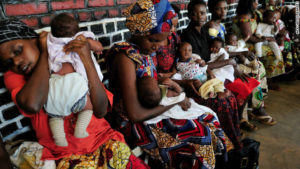African population boom fuelling refugee crisis
An unprecedented population boom in Africa is fuelling the global migration crisis with fertility rates in some parts of the continent soaring as high as almost eight children born to each woman.
As German Chancellor Angela Merkel toured three African nations this week holding talks on curbing migration to Europe, the extent of the issue became clear.
The leader of the world’s poorest country, Niger’s President Mahatma Issoufou, suggested it would take a “Marshall Plan” of massive aid to stop people seeking a pathway to Europe.
 But Ms Merkel responded by expressing concern about how well any aid would be spent and saying that, at a summit in Malta last year, the European Union had already earmarked 1.8 billion euros for a trust fund to train and resettle migrants.
But Ms Merkel responded by expressing concern about how well any aid would be spent and saying that, at a summit in Malta last year, the European Union had already earmarked 1.8 billion euros for a trust fund to train and resettle migrants.
She called on African states to do more to stem migration to Europe and address the rise in Islamic extremism.
In a speech to the African Union (AU) at the culmination of a three-day tour of the continent, Angela Merkel proposed Libya as a “sad example” where state structures had collapsed and the assembly of nations could do more.
“I am expressly in favour of the African Union bringing its influence to bear to help solve the conflict,” she said.
President Issoufou instead proposed a development package that would bringing Niger’s population growth down from 3.9 per cent, the highest in the world.
He was short on details about how this would work but the demographics reveal a compelling argument.
So long as population growth in African countries outstrips their ability to educate, house and employ their citizens, large numbers of people will continue to brave the deserts and seas to escape.
Observers say money won’t resolve the issue.
“There are going to be too many people … the development you need will not be possible. You have to lower fertility rates and bring down population by educating and empowering women,” said Owoeye Olumide, a Nigerian demographer.
Niger is largely a desert nation to the north of Nigeria and is emblematic of the problem.
With an average of 7.6 children born to each woman, its population is projected to more than triple to 72 million by 2050, from about 20 million now, according to the latest UN figures.
By then, Africa will have more than doubled its population to 2.4 billion, the UN says.
Frequent droughts in Niger cause hunger, and low investment in education means a dearth of skills. Yet, at the same time, it must significantly increase food production to feed its people.
Niger’s location in the largely unpoliced sands of the Sahara also makes it a magnet for migrants from across Africa hoping to be smuggled to a better life in Libya or Algeria or over the Mediterranean to Europe.
The International Organization for Migration (IOM) estimates migration through Niger’s Agadez region this year to reach 300,000, more than twice the 120,000 it estimates came through in 2015.
Other observers argue that Africa is on the rise economically and the continent’s population woes will solve themselves.
Then theory is that Africa will reap a “demographic dividend” as its burgeoning youth population drives innovation and consumer markets.
But others say Africa remains over-dependent on raw materials and has failed to create the manufacturing or service jobs that helped drive Asia forwards.
Furthermore economic growth hasn’t significantly cut birth rates in most African countries.
And anyway, even if Africa is ‘rising’, migration may yet remain unstoppable.
Laurie Nowell
AMES Australia Senior Journalist












